bud
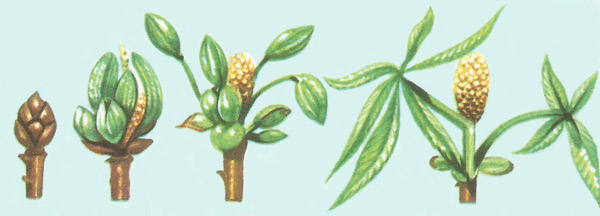
The different stages of development of a horse-chestnut bud.
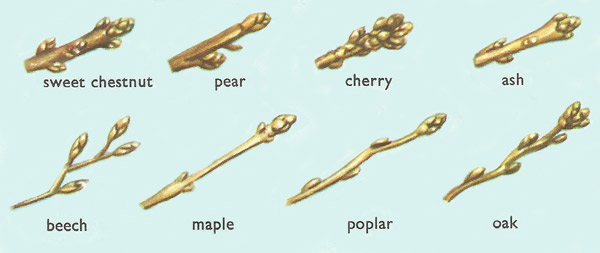
Different types of tree buds.
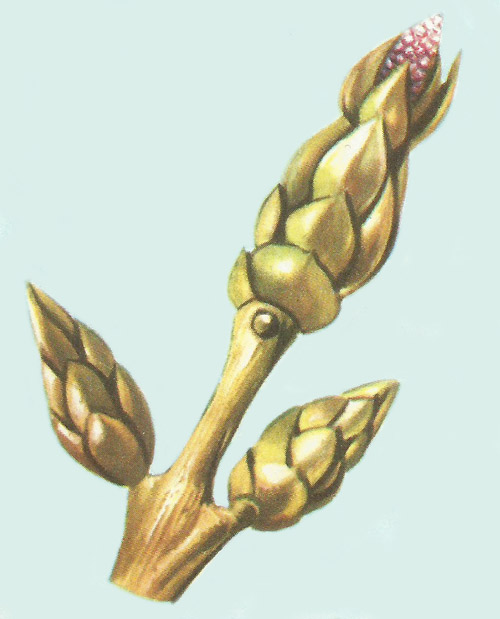
The top or apex of a branch of lilac. The top or apical bud is just opening and is about to reveal countless little blooms. The two buds at the sides, known as lateral buds, will produce new branches and leaves.
A bud is a condensed shoot in which the stem is very short, the inner leaves are closely
packed and the outer scale leaves form a protective covering. In the spring,
the stem elongates rapidly and the leaves unfold. (The term bud is also used in zoology for a point from which new growth develops.)
Every year, at the beginning of spring, young tender leaves appear and spread over all our shrubs and trees like a green veil, and a new life seems to be starting. Even the gnarled old oaks and the spreading elms put on a pale green mantle of small, fresh, delicate leaves. This miracle of nature, repeated every year, owes its occurrence to buds.
Buds are small, tightly packed, well-protected bulges, destined to become either branches, leaves or flowers. A bud at the tip of a twig is a terminal bud and contains the growing point; lateral buds develop in leaf axils along a twig. Axillary buds are found at the point of insertion of leaves or branches and will develop into new branches and new leaves or will open into flowers. In addition to these two main types of bud, every tree and shrub has dormant buds which can lie within the bark for as long as a hundred years without attempting to break forth. But they will always waken in time of need, when, for instance, bad weather, or the handoff man destroyed the existing shoots.
Thus buds provide not only for seasonal growth and renewal of trees, but when necessary they assure the continuation of life itself in the tree. If, for instance, we cut off the top of a fir tree, the terminal bud of one of the side branches will open and push out to lengthen the branch. Moreover, rather than direct itself horizontally, it will stretch upwards so as to take the place of the top of the trunk which has been cut off.
Buds are covered outside with tough, leathery scales (called perulas), which overlap each other like the tiles on a roof. There are many layers of scales because they protect the inmost, tender part of the bud from the rigors of winter and prevent loss of moisture through evaporation. The inmost part of the bud consists of young cells capable of transforming themselves into branches, leaves, or flowers. The bud scales are often helped in their task of protection by small and ingenious accessories.
Thus in the horse chestnut there is a lining if fur; in this tree and in certain types of poplar, the outsides of the buds are coated with resin. Willow buds have an outer hairy covering.
A characteristic protection is that of cauliflower. This edible white curd is really an immensely swollen bud. It might almost be said that the cauliflower consists entirely of a bud round which leaves are massed for protection against the cold.
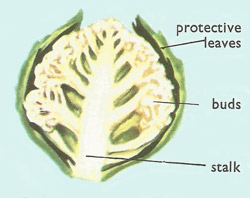 |
| Section of a cauliflower.
|
There are two types of bud in plants: the flower-bud which is plump and will open into a flower, and the leaf-bud which is more tapering in shape and will produce new leaves and fresh twigs or branches. Usually the higher branches of a tree only carry leaf-buds, while the other branches carry buds of both kinds. From the distribution and quantity of the various buds the fruit-grower decides on how to prune his fruit trees.
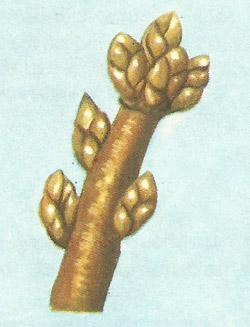 |
| This is how the tops of some cherry branches look at the end of winter. Both leaf-buds (tapering) and flower-buds (plump) are shown.
|
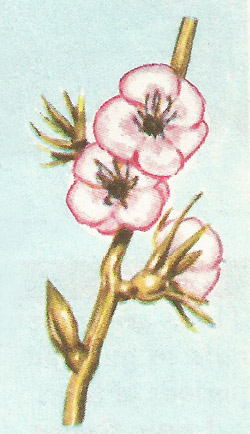 |
| Here is a peach tree in flower. The buds carrying flowers (flower-buds) are fully open; those which will develop into leaves (leaf-buds) are still tightly closed.
|


